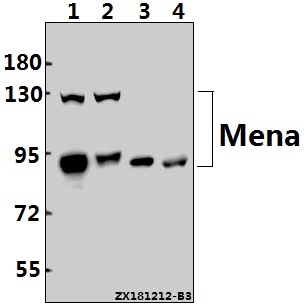Product Name :
Mena (N504) polyclonal antibody Background :
Mena (mammalian enabled), EVL, and VASP are members of the Ena/VASP family, which is involved in controlling cell shape and cell movement by shielding actin filaments from capping proteins. Ena/VASP proteins have three specific domains: an amino-terminal EVH1 domain controlling protein localization; a central proline-rich domain mediating interactions with both SH3 and WW domain containing proteins, including profilin; and a carboxy-terminal domain causing tetramerization and binding to actin. Mena interacts with actin filaments at the growing ends localizing to lamellipodia and to tips of growth cone filopodia in neurons. Axons projecting from interhemispheric cortico-cortical neurons are misrouted in newborn, homozygous Mena knock-out mice. Mena is phosphorylated at Ser236 by PKA, thereby promoting filopodial formation and elongation in the growth cone. Three forms of Mena corresponding to 80, 88 and 140 kD are known. The 80 kD protein is broadly expressed in contrast to the 140 kD protein which is enriched in neural cell types. Alternative splicing produces these forms. The 88 kD protein is mainly found in embryonic cell types and is likely the result of post-translational modification. Expression of all three forms is completely eliminated in Mena homozygous mutant animals. Product :
Rabbit IgG, 1mg/ml in PBS with 0.02% sodium azide, 50% glycerol, pH7.2 Storage&Stability :
Store at 4°C short term. Aliquot and store at -20°C long term. Avoid freeze-thaw cycles. Specificity :
Mena (N504) polyclonal antibody detects endogenous levels of Mena protein. Immunogen :
Synthetic peptide, corresponding to amino acids 474-534 of Human Mena. Conjugate :
Unconjugated Modification :
Unmodification
Mena (N504) polyclonal antibody Background :
Mena (mammalian enabled), EVL, and VASP are members of the Ena/VASP family, which is involved in controlling cell shape and cell movement by shielding actin filaments from capping proteins. Ena/VASP proteins have three specific domains: an amino-terminal EVH1 domain controlling protein localization; a central proline-rich domain mediating interactions with both SH3 and WW domain containing proteins, including profilin; and a carboxy-terminal domain causing tetramerization and binding to actin. Mena interacts with actin filaments at the growing ends localizing to lamellipodia and to tips of growth cone filopodia in neurons. Axons projecting from interhemispheric cortico-cortical neurons are misrouted in newborn, homozygous Mena knock-out mice. Mena is phosphorylated at Ser236 by PKA, thereby promoting filopodial formation and elongation in the growth cone. Three forms of Mena corresponding to 80, 88 and 140 kD are known. The 80 kD protein is broadly expressed in contrast to the 140 kD protein which is enriched in neural cell types. Alternative splicing produces these forms. The 88 kD protein is mainly found in embryonic cell types and is likely the result of post-translational modification. Expression of all three forms is completely eliminated in Mena homozygous mutant animals. Product :
Rabbit IgG, 1mg/ml in PBS with 0.02% sodium azide, 50% glycerol, pH7.2 Storage&Stability :
Store at 4°C short term. Aliquot and store at -20°C long term. Avoid freeze-thaw cycles. Specificity :
Mena (N504) polyclonal antibody detects endogenous levels of Mena protein. Immunogen :
Synthetic peptide, corresponding to amino acids 474-534 of Human Mena. Conjugate :
Unconjugated Modification :
Unmodification
-
 Western blot (WB) analysis of Mena (N504) polyclonal antibody at 1:500 dilution Lane1:MCF-7 whole cell lysate(20ug) Lane2:Beas-2B whole cell lysate(40ug) Lane3:The Prostate tissue lysate of Rat(40ug) Lane4:The Embryo tissue lysate of Mouse(40ug)
Western blot (WB) analysis of Mena (N504) polyclonal antibody at 1:500 dilution Lane1:MCF-7 whole cell lysate(20ug) Lane2:Beas-2B whole cell lysate(40ug) Lane3:The Prostate tissue lysate of Rat(40ug) Lane4:The Embryo tissue lysate of Mouse(40ug)
Bioworld Biotech only provide peptides for our antibodies and do not provide additional peptide customization services.
Price/Size :
USD 368/1mg/vial
Tips:
For phospho antibody, we provide phospho peptide(0.5mg) and non-phospho peptide(0.5mg).Describe :
Blocking peptides are peptides that bind specifically to the target antibody and block antibody binding. These peptide usually contains the epitope recognized by the antibody. Antibodies bound to the blocking peptide no longer bind to the epitope on the target protein. This mechanism is useful when non-specific binding is an issue, for example, in Western blotting (WB) and Immunohistochemistry (IHC). By comparing the staining from the blocked antibody versus the antibody alone, one can see which staining is specific; Specific binding will be absent from the western blot or IHC performed with the neutralized antibody.Formula:
Synthetic peptide was lyophilized with 100% acetonitrile and is supplied as a powder. Reconstitute with 0.1 ml DI water for a final concentration of 10 mg/ml.The purity is >90%,tested by HPLC and MS.
Storage:
The freeze-dried powder is more stable. For short time at 2-8°C. For long term storage store at -20°C.
Note :
This product is for research use only (RUO only). Not for use in diagnostic or therapeutic procedures.
 Mena (N504) polyclonal antibody
Mena (N504) polyclonal antibody  Datasheet
Datasheet COA
COA MSDS
MSDS SHIP
SHIP